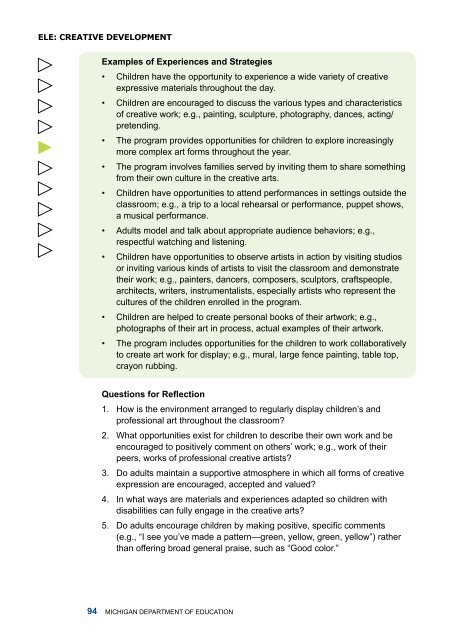Early Childhood Standards of Quality for ... - State of Michigan
Early Childhood Standards of Quality for ... - State of Michigan
Early Childhood Standards of Quality for ... - State of Michigan
You also want an ePaper? Increase the reach of your titles
YUMPU automatically turns print PDFs into web optimized ePapers that Google loves.
ELE: Creative DevelopmentExamples <strong>of</strong> Experiences and Strategies• Children have the opportunity to experience a wide variety <strong>of</strong> creativeexpressive materials throughout the day.• Children are encouraged to discuss the various types and characteristics<strong>of</strong> creative work; e.g., painting, sculpture, photography, dances, acting/pretending.• The program provides opportunities <strong>for</strong> children to explore increasinglymore complex art <strong>for</strong>ms throughout the year.• The program involves families served by inviting them to share somethingfrom their own culture in the creative arts.• Children have opportunities to attend per<strong>for</strong>mances in settings outside theclassroom; e.g., a trip to a local rehearsal or per<strong>for</strong>mance, puppet shows,a musical per<strong>for</strong>mance.• Adults model and talk about appropriate audience behaviors; e.g.,respectful watching and listening.• Children have opportunities to observe artists in action by visiting studiosor inviting various kinds <strong>of</strong> artists to visit the classroom and demonstratetheir work; e.g., painters, dancers, composers, sculptors, craftspeople,architects, writers, instrumentalists, especially artists who represent thecultures <strong>of</strong> the children enrolled in the program.• Children are helped to create personal books <strong>of</strong> their artwork; e.g.,photographs <strong>of</strong> their art in process, actual examples <strong>of</strong> their artwork.• The program includes opportunities <strong>for</strong> the children to work collaborativelyto create art work <strong>for</strong> display; e.g., mural, large fence painting, table top,crayon rubbing.Questions <strong>for</strong> Reflection1. How is the environment arranged to regularly display children’s andpr<strong>of</strong>essional art throughout the classroom?2. What opportunities exist <strong>for</strong> children to describe their own work and beencouraged to positively comment on others’ work; e.g., work <strong>of</strong> theirpeers, works <strong>of</strong> pr<strong>of</strong>essional creative artists?3. Do adults maintain a supportive atmosphere in which all <strong>for</strong>ms <strong>of</strong> creativeexpression are encouraged, accepted and valued?4. In what ways are materials and experiences adapted so children withdisabilities can fully engage in the creative arts?5. Do adults encourage children by making positive, specific comments(e.g., “I see you’ve made a pattern—green, yellow, green, yellow”) ratherthan <strong>of</strong>fering broad general praise, such as “Good color.”94 <strong>Michigan</strong> Department <strong>of</strong> Education


